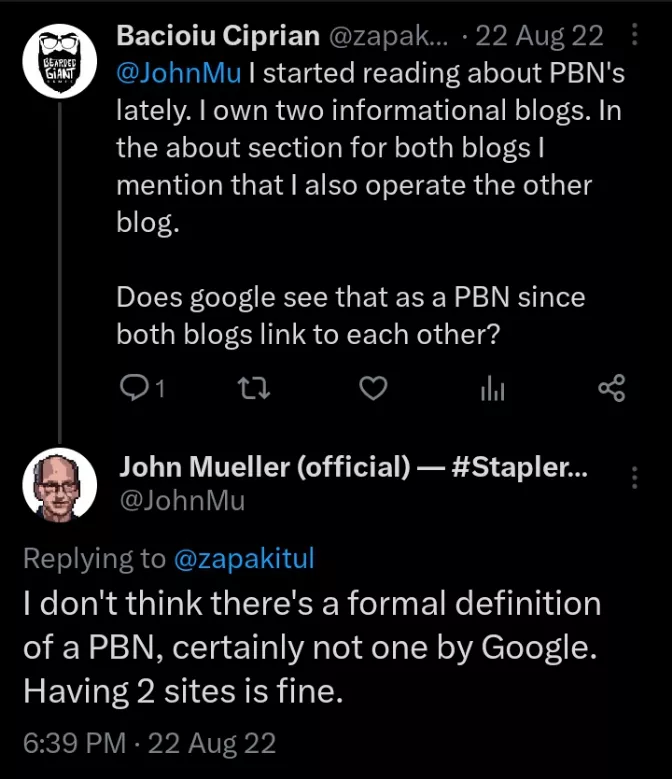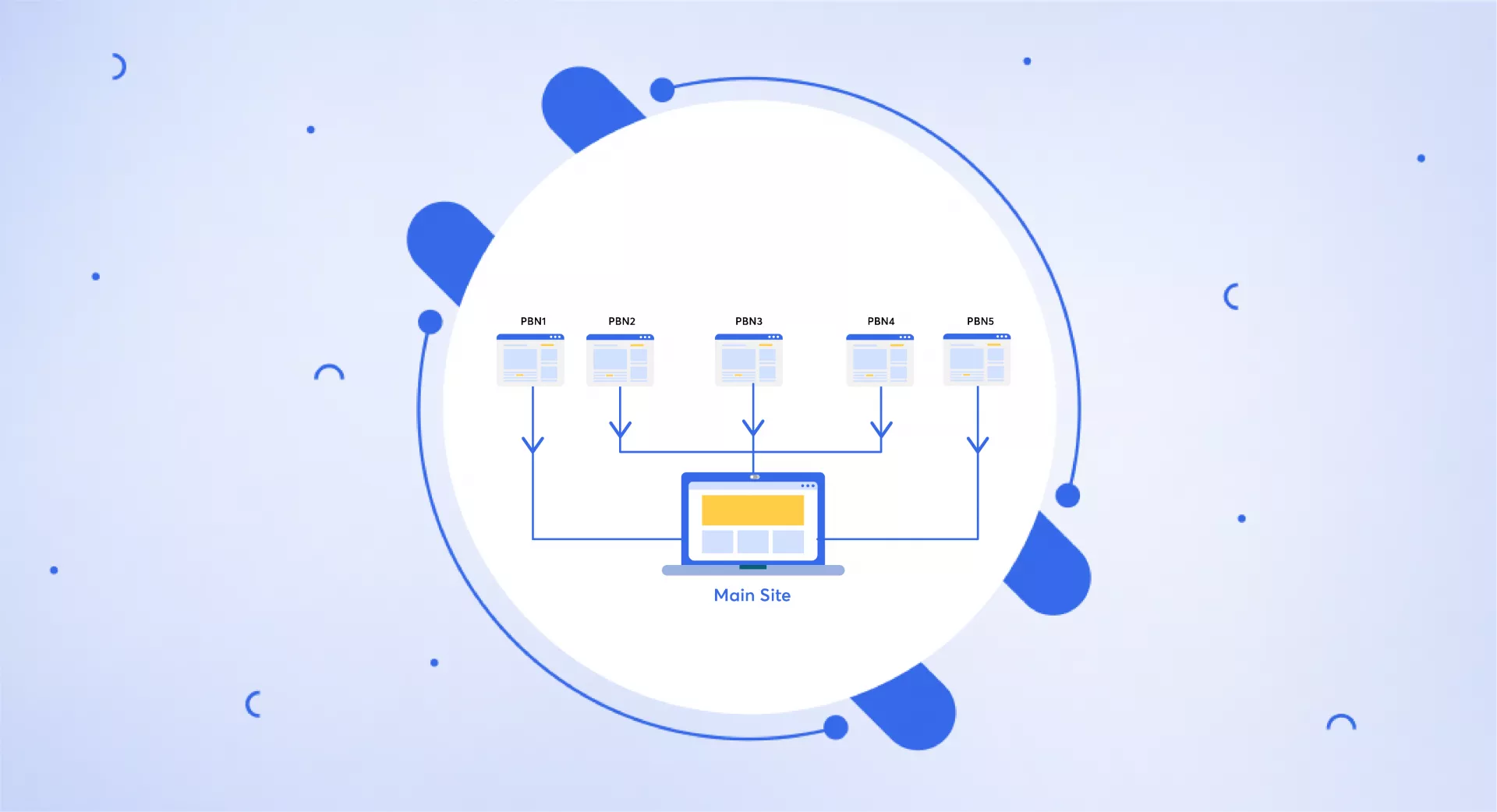What is a PBN?
A PBN (Private Blog Network) is a group of websites that are usually owned by an individual or entity to manipulate the rankings of a website.
The purpose behind PBN is to increase the authority of a website as search engines give weightage to backlinks. The websites in a PBN are designed in a way that seems legitimate.
These sites often have unique domain names, designs, and content to avoid detection by search engines.
How does Google define it?
Google does not have a proper definition of PBN. This concept is usually defined by SEOs. Therefore, you cannot apply a single specified concept to any group of sites or blogs.
As John Mueller confirms this:

How does it work?
Backlinks from other sites help tell search engines that a website is useful for certain topics. More backlinks, especially from authoritative sites, generally improve rankings.
A PBN tries to exploit this for higher rankings. It operates by either acquiring a group of expired but authoritative domains or by purchasing multiple domain names to build their authority over time.
Once the PBN network is established, the websites in this network start publishing content. The links are added to this content that point to the main website which this PBN is aiming to promote.
The more backlinks to the target site means more authority or endorsement. This is done to trick the search engines to rank that target website higher with manipulative tactics rather than quality content.
Does it violate Google’s guidelines?
Yes, PBNs violate Google's Webmaster Guidelines and it is strongly recommended to avoid using them.
According to Google's link spam guidelines, links intended to manipulate search rankings are considered link spam. It includes manipulating both inbound and outbound links.
PBNs also fall under the category of link spam. These links are not earned naturally but are instead strategically built.
Why do people use it?
Despite its negative consequences, people still use PBN because of two main reasons:
Difficulty in link-building
Legitimate link-building is a long and tiring process. It requires much effort to build strong connections with authoritative sites or to get quality backlinks.
Even if someone wrote exceptional content, there is no guarantee they are going to get a link instantly from other sites.
PBNs offer a way to have more control over the backlinking process. People choose to create them to bypass the painful or lengthy process of link building.
Anchor text manipulation
Another reason for using PBNs is to get great control over the anchor text of backlinks. The anchor text can impact a website's ranking for a specific, relevant keyword.
When a keyword-rich anchor text is used, it shows relevancy to the linked page.
So PBN owners can strategically create backlinks with anchor texts of their own, potentially improving ranking for the target keyword.
How do we identify PBNs?
Before identifying any PBN network, keep in mind that earlier it was easy to spot a PBN due to the same IP address, shared servers, WHOIS information and duplicate content. Today, it is a bit complicated to detect them.
Here are several factors to consider when trying to identify a PBN site:
Hosting: You may check if the sites are hosted on the same IP address. Take help from tools like SpyOnWeb.com or Host.io.
Site design: You may also look for similarities in design or colour schemes across different sites as these PBNs may use similar design elements.
Similar themes: Sometimes, PBNs use the same WordPress theme across all sites. Checking the source code of the websites may reveal if they do so.
Site ownership: Investigate the WHOIS database for the contact information of the site owners. Hidden WHOIS data can be a red flag. If all the site owners are the same, it suggests a connection between the blogs.
Duplicate content: If you suspect the credibility of a site's content, just check for its content online. If the same content appears on other sites, it indicates the presence of duplicate content, which may be a characteristic of PBNs.
Backlink profile: Analyze the backlink profile of the sites. If there is excessive interlinking between sites within the network, it can be an indication of a PBN.
Images and videos: Duplicate images and videos can also be a sign of a PBN. Conduct reverse image or video searches using Google to identify similar pieces of visual content.
Owning multiple websites doesn't necessarily mean operating a PBN.
Many agencies like media companies have multiple related sites. They also naturally link to each other without raising suspicion.
But if unrelated sites have dozens of links in footers or repeatedly link to similar internal pages, it can be a cause for concern.
Risks associated with using PBNs
Like every spammy practice, there are risks associated with PBNs too.
They can be ignored
Google provides users with high-quality and relevant search results.
When Google detects manipulative linking practices, it chooses to ignore those links entirely. This means that even if you invest time, money, and effort into building those links, they won't have any positive impact.
As John Mueller replied to a tweet:

PBN links can trigger a penalty
Google aims to provide fair and trustworthy search results, and attempts to manipulate rankings are against its guidelines.
Google can respond to a PBN in two ways:
a) Manual Penalty: Google has human reviewers to review the websites and their backlink profiles. If they detect manipulative tactics for rankings like using PBNs, they can issue a Manual Penalty. A warning message in GSC will be issued to the website owner, informing them about unnatural links.
b) Ignoring PBN links: As mentioned earlier, Google usually ignores PBN links altogether.
As a result of the penalty, the website can be deindexed completely.
Exploding the common myths around PBNs
Here are some common myths about PBNs.
They don’t work
One common myth is that Private Blog Network links do not have any effect on rankings.
This is not true. PBN links can help improve rankings, despite violating Google's guidelines.
Once it is identified by Google, a PBN site may be completely removed from its index.
Therefore, there is a good chance that PBN links will provide a temporary boost to your site, only for a short duration.
They are easily identifiable
This is another common myth. Though Google is smart enough to detect manipulative links, PBNs are not that easy to identify.
Let's see why this myth needs to be debunked.
Evolving nature of PBNs: SEOs are well aware of algorithmic changes, so they also work actively to minimise their chances of getting caught by search engines.
Overlapping footprints: While shared IP addresses and web hosting are considered potential footprints, they do not always represent a PBN. It is very common for websites to share an IP address, a hosting provider or get a domain from auction to legitimately repurpose it.
Complex link patterns: Google considers multiple factors while evaluating links. Despite all the efforts, it is still a challenging task to identify the patterns of links among several websites. SEOs take several steps to make their links appear more organic.
All paid links come from a private blog network
It is another misconception. Although PBN indeed offers paid links, not all paid links are part of a PBN.
It is common for websites to sell links or offer sponsored posts for financial purposes, but that does not mean they are all part of a PBN network.
All groups of sites that link to each other are PBNs
It is also incorrect to say that all the websites linked to each other are a part of PBN. Many businesses operate multiple websites to target a specific audience, reach different markets and sell their products or services.
In all those cases, it is legitimate to interconnect one website to another.
What to do to avoid PBN links?
You will never be advised to use a PBN for link building by a professional SEO.
If you want to prevent those links, it is better to take several steps to ensure this:
If you are outsourcing your link-building activity, be aware of any manipulative practices and avoid them as they will put your website in danger.
Avoid buying links from platforms like Fiverr or other similar services. It may seem tempting but these links are often of low quality and will ultimately detected by Google. That may result in penalizing your website.
Always keep an eye on Google updates and guidelines. Beware of link schemes to understand what practices to avoid.
Do not just create the links, also monitor and audit them. Checking your links regularly and taking action against any suspicious links will help you maintain your site's reputation in Google's eye.
Best practices for getting legitimate links
To achieve ethical and long-lasting results in SEO, consider the following white hat techniques:
Do the due diligence
While contacting a link-building agency, conducting due diligence is essential. Some agencies may deceptively present PBN links as legitimate ones.
It's recommended to request and thoroughly evaluate samples of their previous work. You need to look for indicators that may suggest the presence of a PBN, such as:
low organic traffic to the linked sites
the use of unnatural link placement
poor overall site quality
Create quality content
Create high-quality and relevant content that meets the needs of your target audience.
Make it more valuable by adding relevant keywords and publishing regularly to increase your website's worth and attract authoritative links.
Get real backlinks
Though it is a slow process, the results are worth it. Focus on acquiring high-quality and authoritative links by creating valuable content.
In the long run, it will significantly help your website and boost its overall authority.
Conclusion
PBNs involve illegitimate link-building practices that are strictly prohibited by Google. If you are involved in such practices, you must immediately stop doing this, as it can significantly put your site at risk and can destroy its search engine visibility.
If you genuinely want to avoid these networks, you must understand the difference between legitimate groups of interconnected sites and PBNs.


